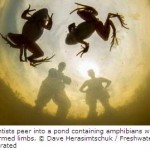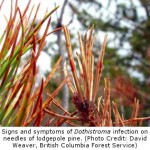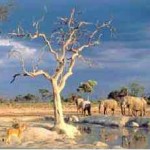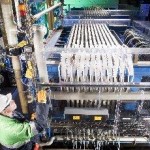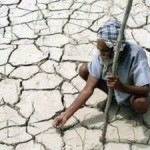 The ‘brightest’ biological organism on land, the Pollia condensata fruit, does not get its blue colour from pigment but instead uses structural colour. Structural colour is produced by light interference. By structuring transparent material at the nano-scale, it is possible to produce bright and intense colouration that depends on the structure of the material more than on the chemical composition of the material.
The ‘brightest’ biological organism on land, the Pollia condensata fruit, does not get its blue colour from pigment but instead uses structural colour. Structural colour is produced by light interference. By structuring transparent material at the nano-scale, it is possible to produce bright and intense colouration that depends on the structure of the material more than on the chemical composition of the material.
Although most colours around us are the result of pigments, many examples of colour in nature are structural. The simplest case is the soap bubble: the solution used to produce soap bubbles is generally transparent, but as soon as the bubble is formed, it is possible to observe all the colours of the rainbow due to the thin film of solution that is formed when the bubble is created and the interference of that film with light.
In nature, interference effects of light are also responsible for the colours of some species of animals – including the peacock and pigeon feathers, the exocuticle of scarab beetles and many different fish. Structural colour is also found in the plant kingdom, some flowers use diffraction grating-like structures to produce iridescent colouration and now the Pollia condensata fruit has been discovered to use a cellulose-based photonic nano-structure to produce its intense blue colouration. Because structures do not degrade like pigments do, the colour of the Pollia condensata fruit does not fade over time. Fruits conserved in the herbarium collections of the Royal Botanic Gardens, Kew, U.K., dating back to the 19th century, are still as colourful and shiny as ones grown today.
 In general, fruits are made of cells, each of which is surrounded by a cell wall containing cellulose. In the case of the Pollia condensata fruit, the cellulose contained in the cell wall is laid down in layers, forming a chiral (asymmetrical) structure that is able to interact with light and provide selective reflection of only a specific colour. Each cell of the fruit acts as a micro-mirror that reflects only a specific range of wavelengths, so a specific colour of light. The thickness of the layers determines which wavelength of light is reflected. As a result, some cells have thinner layers and reflect blue; others have thicker layers and reflect green or red. Because each individual cell reflects colour independently, the epicarp of the fruit produces a pixelated or pointillist effect (like those in the paintings of Seurat).
In general, fruits are made of cells, each of which is surrounded by a cell wall containing cellulose. In the case of the Pollia condensata fruit, the cellulose contained in the cell wall is laid down in layers, forming a chiral (asymmetrical) structure that is able to interact with light and provide selective reflection of only a specific colour. Each cell of the fruit acts as a micro-mirror that reflects only a specific range of wavelengths, so a specific colour of light. The thickness of the layers determines which wavelength of light is reflected. As a result, some cells have thinner layers and reflect blue; others have thicker layers and reflect green or red. Because each individual cell reflects colour independently, the epicarp of the fruit produces a pixelated or pointillist effect (like those in the paintings of Seurat).
 The biological implications of such peculiar coloration are about successful seed dispersal. Pollia condensata fruits provide no fleshy reward to the birds that eat them – the birds either think it is a juicy blue fruit (so it’s a mimic), or they collect the fruits for nest or bower decoration and to help them impress mates.
The biological implications of such peculiar coloration are about successful seed dispersal. Pollia condensata fruits provide no fleshy reward to the birds that eat them – the birds either think it is a juicy blue fruit (so it’s a mimic), or they collect the fruits for nest or bower decoration and to help them impress mates.
The observation of such structures can be really useful for scientists since biological photonic structures can provide broad inspiration for novel artificial materials. By learning from nature, it is possible to obtain smart multifunctional materials that are fabricated by sustainable routes using abundant and cheap materials like cellulose.
Using cellulose to create coloured materials can lead to many industrial applications. As an example, edible cellulose-based nanostructures with structural colour can be used as substitutes for toxic dyes and colorants in food. Moreover, the fact that the processes involved in cellulose extraction and manipulation are already used in the paper industry facilitates the use of such materials for industrial applications such as security labelling or cosmetics.
About the Authors:
The article is written by Dr. Silvia Vignolini, Prof. Ullrich Steiner and Dr. Beverly Glover, and summarizes the findings of a recent research study titled “Pointillist Structural Color in Pollia Fruit” published on September 11 in the journal PNAS.
The research was supported by the Leverhulme Trust with some funding provided by the Engineering and Physical Sciences Research Council (EPSRC).
Dr. Silvia Vignolini is a Post Doctoral Research Associate at the University of Cambridge, Physics Department, Cavendish Laboratory, in the group of thin film and interfaces. Prof. Ullrich Steiner is a John Humphrey Plummer Professor of Physics of Materials and Dr. Beverly Glover is a Reader at Department of Plant Sciences at the University.
About “Learning from Nature” Series
ThinktoSustain.com keeps track of innovations for sustainability from all walks of life. Nature has immense knowledge embedded in various life forms. We believe that Learning from Nature can help us solve many problems and live sustainably. The “Learning from Nature” series presents such innovations with a view to trigger innovative thought process.
If you or your organization have demonstrated such sustainable innovations, do write to us (giving a brief description) at editor@thinktosustain.com.
© 2012 ThinktoSustain.com. All Rights Reserved.
More from “Learning from Nature” Series:

